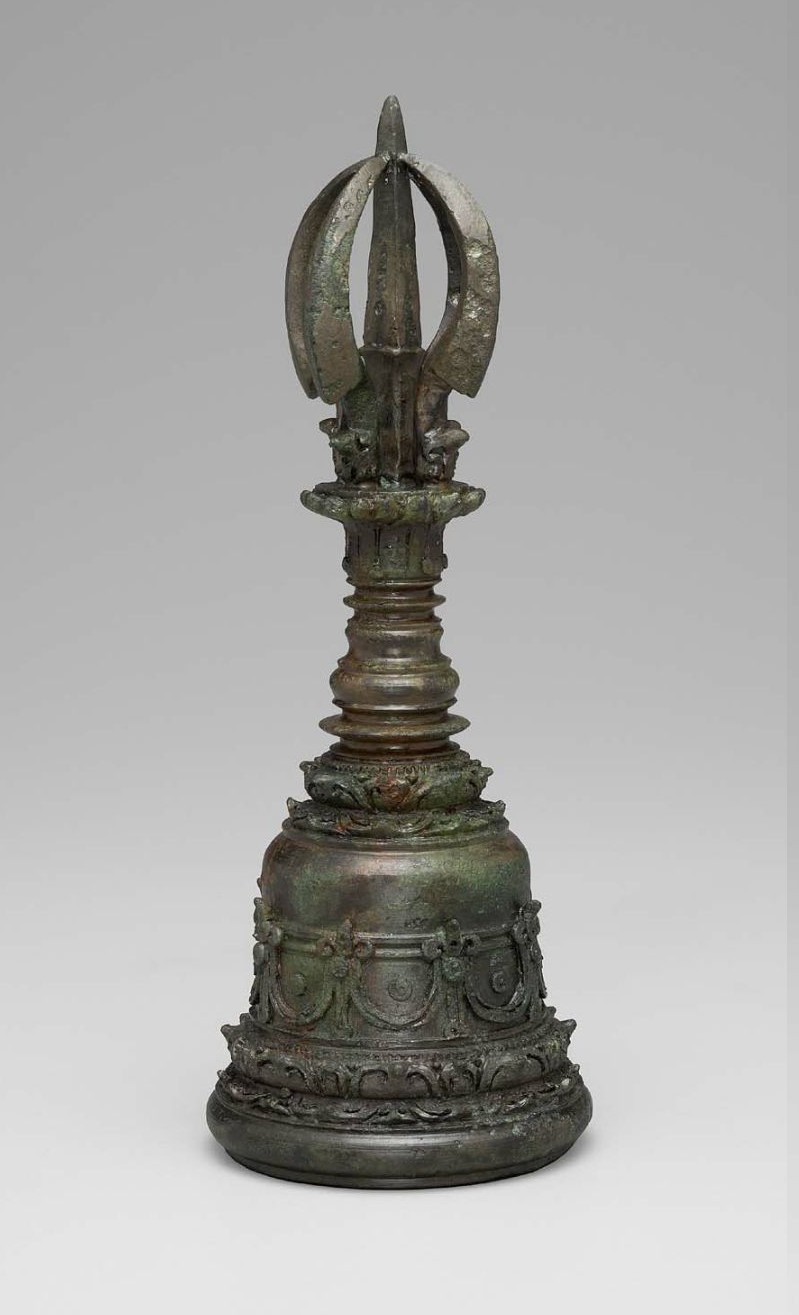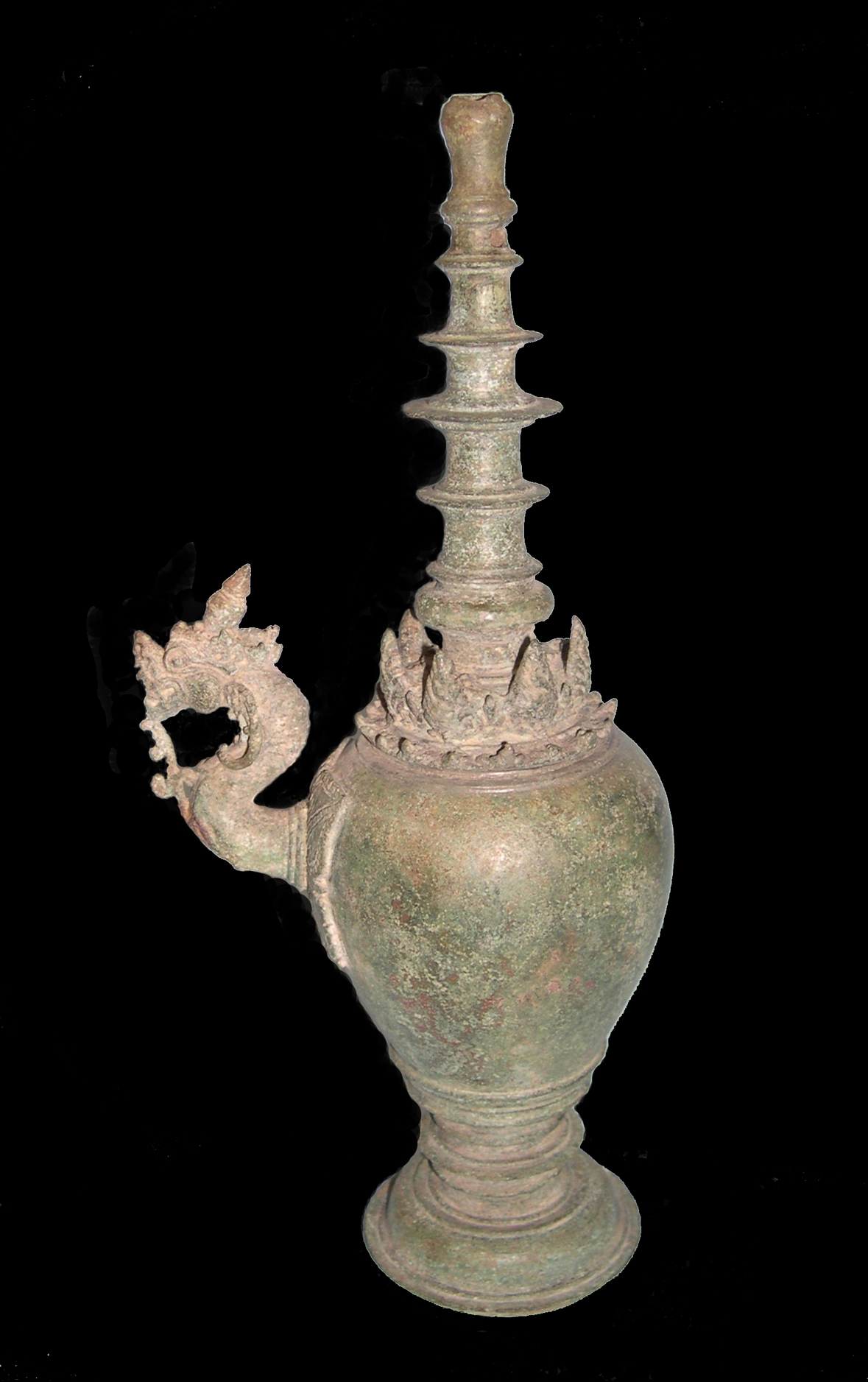Ancient Javanese Bronze Artefacts
Apart from figurines, bronze was used for making many types of artefacts in ancient times. These included bells, vessels and weapons, The following artefacts were made by the lost-wax process. Some museum examples are included and the last item is included because it is an exceptional example of early bronze casting in the form of a drum found in Bali that originated from the Dong Son culture located in what is now northern Vietnam. The numbered images are part of the Apsarah Gallery Collection.
Gantha – Temple Bell
 Material: bronze.
Material: bronze.
Patina: light brown.
Period: 11th – 12th century.
Dimensions: height 34.9 cm.
This temple bell is reported to be 11th to 12th century from eastern Java. From the inscription, which appears to be in Jawa Kuna using a script known as aksara Kadiri kwadrat (Kediri square script), this dating is probably correct.
This bell is located in the collection of the Metropolitan Museum of Art, New York.
1. Gantha – Temple Bell
 Material: bronze.
Material: bronze.
Patina: dark greenish-brown.
Dimensions: height 30 cm.
This temple bell probably originated in central Java. It follows the designs seen on similar items from the Hindu-Buddhist period in the 9th to 11th centuries, topped by a simhavyala (lion-faced guardian) of fierce disposition and a hanging ring behind the head. Note the similarity of the simhamukha to the kirtimukha.
Although there are similarities to the bell above, which probably came from the Kediri Kingdom in eastern Java, its coloration and shape are closer to examples from central Java (see following item). Its actual provenance is unknown.
Gantha – Bell with Vajra Handle
 Material: bronze.
Material: bronze.
Patina: greenish-brown.
Dimensions: height 21 cm.
This temple bell is reported to be 10th century from central Java. It follows the designs seen on similar items from the Hindu-Buddhist period in Java. On the handle, it has a five-pronged vajra (lightning bolt) similar to those found in Tibet and usually used by high-ranking priests.
The bell is in the collection of the Museum of Fine Arts, Boston.
2. Gada – Cudgel
 Material: bronze.
Material: bronze.
Patina: greenish brown.
The gada (cudgel) is a weapon often shown carried by temple guardians and characters in the Ramayana or Mahabharata. See also Bathara Kala and Prabhu Menak Jingga figurines.
This item has typical Javanese ornamentation and Kawi script on it.
Kundika – Water Vessel
 Material: bronze.
Material: bronze.
Patina: greenish brown.
This kundika is 273 mm in height. It is located at the British Museum and is said to be a Kamandalu q.v. from Java and is dated ca. 1200. The spout is in the form of the head of a dragon..
It is listed here as a kundika which is the term more often used for a smaller vessel with a spout.
3. Kundika – Water Vessel
 Material: bronze.
Material: bronze.
Patina: greenish brown.
These are perhaps symbolic miniatures of the larger kundika vessels such as shown above. They have Javanese ornamentation and Kawi script. The spout is in the form of the head of a dragon.
Balinese Bronze Drum Material: bronze.
Material: bronze.
Patina: dark brown.
Dimensions: height ~ 45 cm cm.
Period: 2nd century BCE – 1st century CE.
It is claimed that that the island of Bali acquired metallurgical techniques from Dong Son traders even before the 3rd century BCE and produced this type of drum locally in Bali. The raw materials to make bronze were not known to exist in Bali. Although some metallurgical techniques may have been acquired leading to the production of small items such as spear heads, I would contend that the drums found in Bali and as far east as Alor were brought by the Dong Son traders as late as the 1st – 2nd century CE. This is also supported by comparing the decorations, which are similar to those on drums found in Vietnam and other parts of Southeast Asia and China.
This drum is located in the collection of the Bali Museum.